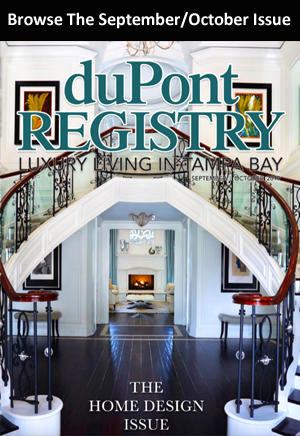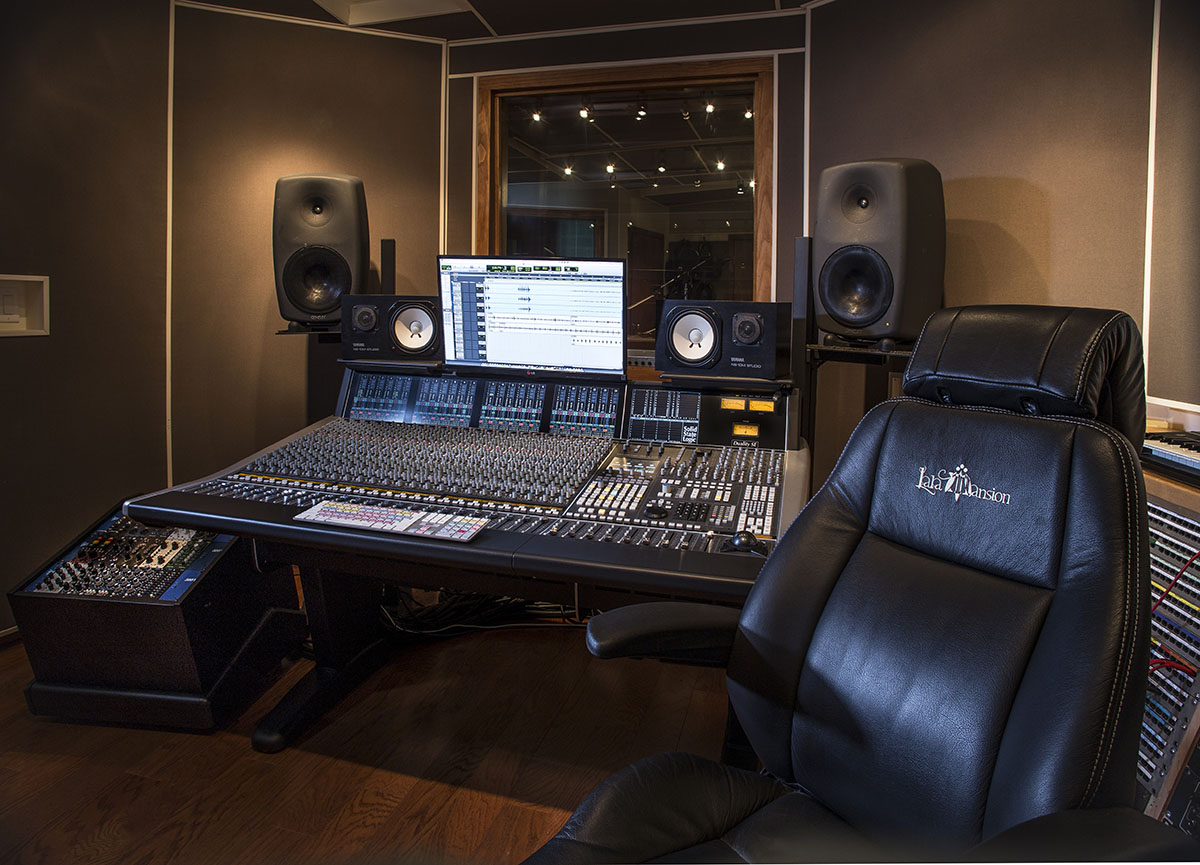A story from duPont REGISTRY Tampa Bay’s annual Home Design Issue. Cover photo by Michelle Miller Design.
These days, home theaters are all about the Mega-TVs — 4K, Ultra-HD, LCD, OLED, QLED — SurroundSound, soundbars and the rest. That’s cool and all, but how about just listening to some music? Surely, there are lots of us who merely want to hear Stevie or Miles or Rachmaninoff or Skynyrd and leave the television black for a while.
And it’s not just listening. It’s playing music and recording it, too. How do you go about buying a high-end loudspeaker system that sounds fantastic and also looks beautiful? What are the particulars of buying a gorgeous grand piano for your great room? How about setting up a home recording studio so you can document your guitar prowess? Read on. We’ve got the latest.
Sound Sculpture
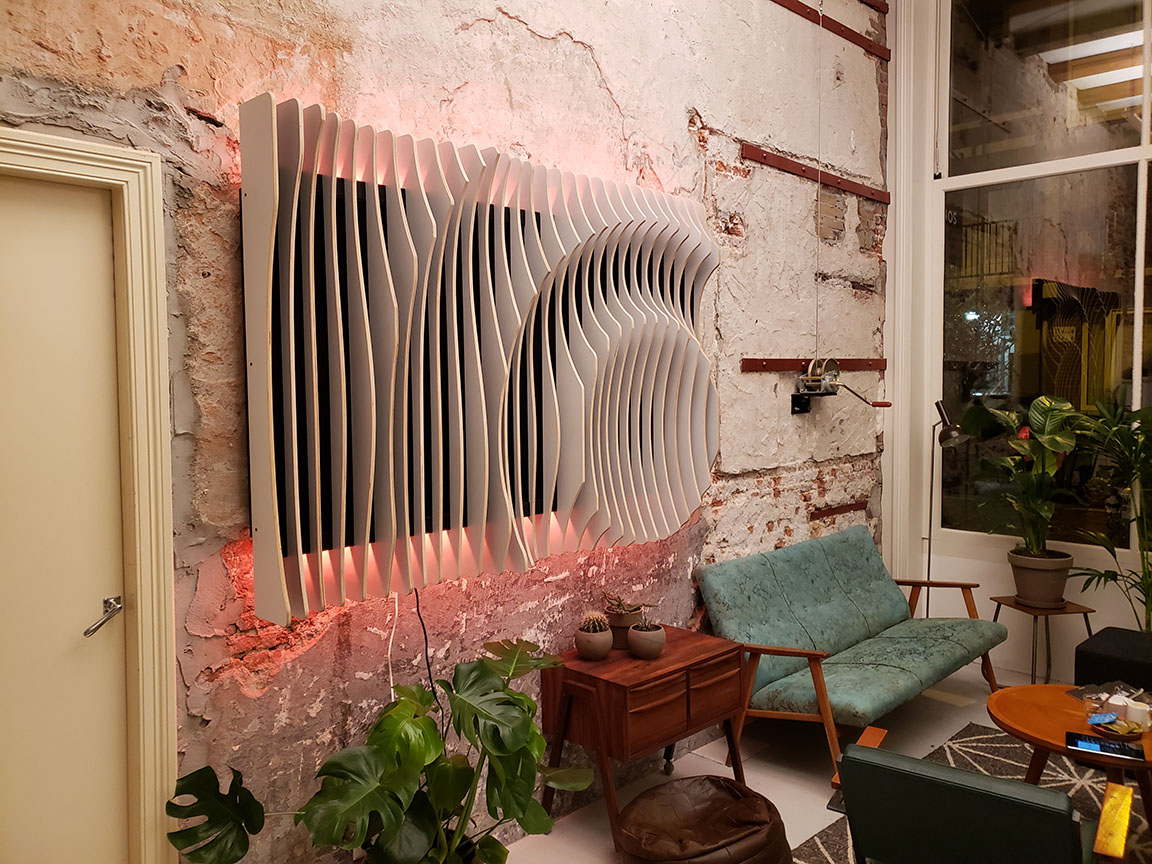
Stereo speakers aren’t just about sound anymore. Sure, budget and mid-priced models are still essentially boxes with components inside, but the higher the price and quality, the more exotic they can get. And visual aesthetics have become an important factor. “How the speakers look in the room is a big part of the decision with our customers who are getting home installations,” says Steven Argote, a salesperson at Rick’s Electronics Boutique in downtown St. Petersburg. “A lot of them might be using interior designers, too.”
Buying high-end loudspeakers for your home these days is a matter of extremes. On one end of the spectrum are what’s called invisible speakers. That’s where the units are installed in the wall, then covered by a paper-thin layer of the actual wall material. Rick’s Electronics Boutique oversaw an installation in Shore Acres that included placing more than 20 speakers by Stealth Acoustics in walls throughout the house. Project cost? About $125,000. The result? No visual evidence of speakers whatsoever. Just sound. On the other end of the spectrum are speakers that are effectively works of art. They come in bold colors and shapes, and most of them are quite large. There’s an encyclopedic array of products that fit into this niche category, but the staff at Rick’s has some favorites — mostly because the sound quality matches or exceeds the stunning design.
The parabolic, vaguely fish-shaped Kef Blade ($31,999 a pair) stands 62 inches high and makes quite an impression in a room — even more so when you run music through them and the much-lauded sound comes pouring out. Consumers can also opt for the somewhat smaller Kef Blade TWO, at $24,999. Both versions come in gleaming all black or all white.
Argote says that color has lately been an important factor, as in the Neolith ($79,995 a pair) by Martin Logan. These come in vibrant red and rich blue, as well as wood grain. The Kansas company’s Masterpiece Series of electrostatic speakers includes four lower models, similarly shaped, the least expensive costing $6,495 a pair. Weird fact: the first electrostatic (as opposed to magnetic) speakers, produced in the 1920s, were made of pig intestines, honed razor thin, and leafed with gold to make them conductive. Martin Logan’s iterations are prized for their sonic accuracy, their beauty — and they smell a lot better than their early predecessors.
For something really different, there’s Leon, a company in Ann Arbor, Michigan that likes “to mix art with audio, and design with technology,” says its president/founder, Noah Kaplan. In the event you want a speaker system on your wall that looks as if Salvador Dalí got ahold of a giant wall-unit air conditioner, there’s Leon’s Ente Sound Sculpture — a speaker array built into a wavy series of slats made from Baltic Birch Plywood. It’s 74 inches wide, 52 inches high and just four inches deep. A bargain at 14 grand.
Grand Slam
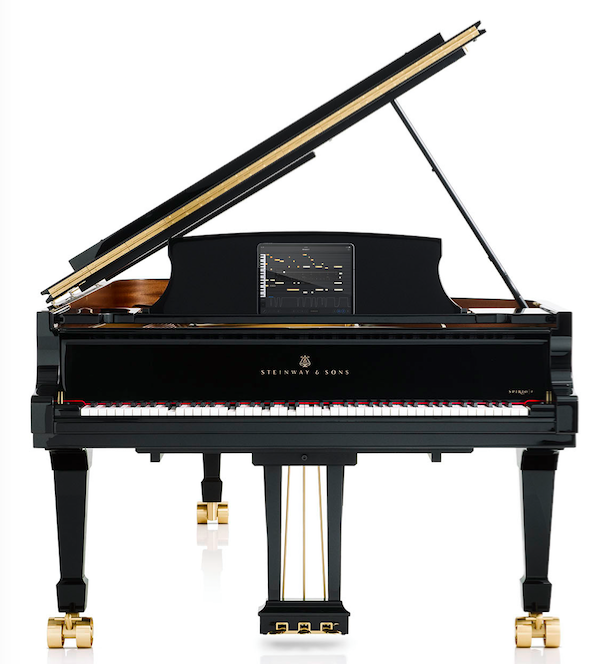
There’s a new reason to buy a grand piano other than admiring how it looks in the great room or plunking a child in front of it. Meet Spirio, the wireless, high-definition player piano system exclusive to Steinway, widely regarded as the maker of the finest pianos in the world.
Player pianos have been around for centuries, but it wasn’t until Spirio debuted two years ago that the music they produced was truly lifelike. “The system fires at over 1,000 levels of intensity, relating to volume and dynamics,” says Jonathan Hunt, manager of The Music Gallery, a large showroom in Clearwater that is the bay area’s exclusive Steinway dealer. “Spirio is so much more expressive. Older systems would all play at the same volume and sound flat.”
I had to experience this for myself, so I stopped in at the store on a Friday afternoon. Jonathan walked me over to a 6-foot-11-inch Steinway, pulled out a large tablet that controls Spirio and asked what I’d like to hear. I requested one of my favorites, jazz legend Bill Evans. After a few screen taps, out poured Evans, digitally re-created, the tone and phrasing clearly his. We went through Vladimir Horowitz, Thelonious Monk, Art Tatum and others, all of them sublimely authentic, startlingly present. As the rich sound flooded the room, the keys moved autonomously. It’s worth noting that Spirio does not come with backing tracks; it’s purely a piano generator, and it’s only available on new Steinways.
Jonathan says that Spirio has spurred a boost in Steinway sales at his store and beyond, calling it a “game-changer.”
“It’s helped bring in a whole new buyer,” he says. “We’ve had single, professional, non-piano-playing men buying $100,000 pianos equipped with Spirio. It’s a segment we never saw before.” You may be wondering: Isn’t this what high-end stereo speakers are for? “Most of our buyers have very sophisticated stereo systems, because they’re audiophiles searching for that sound,” Jonathan explains. “But you can have a $2 million stereo system and it’s still coming out of a speaker. Although Spirio is digitally generated, it’s the closest people can get to pure acoustic sound.” Steinways come in six models, ranging in length from 5-foot-1-inches (priced at $71,000) to 9 feet, which will set you back $176,300. Add about $25,000 for Spirio (all content in perpetuity is included). Because each Steinway piano is made by hand in New York City over the course of 13 months, the increased demand finds the company only making shiny black ones. White or wood-grain models can be ordered custom, but selecting a different finish adds six months to the delivery time.
The Music Gallery staff will come to interested buyers’ homes, assess the spaces available and make recommendations about instrument size and placement. They’ll also bring along a piano template, a flat piece of heavy-gloss paper shaped like a piano that can be adjusted to five different sizes and easily moved around the room.
So there you have it. And remember — you can channel the piano greats via Spirio, but the Steinway’s such a gorgeous instrument that it’d be a shame not to play it, too.
A Musical Refuge
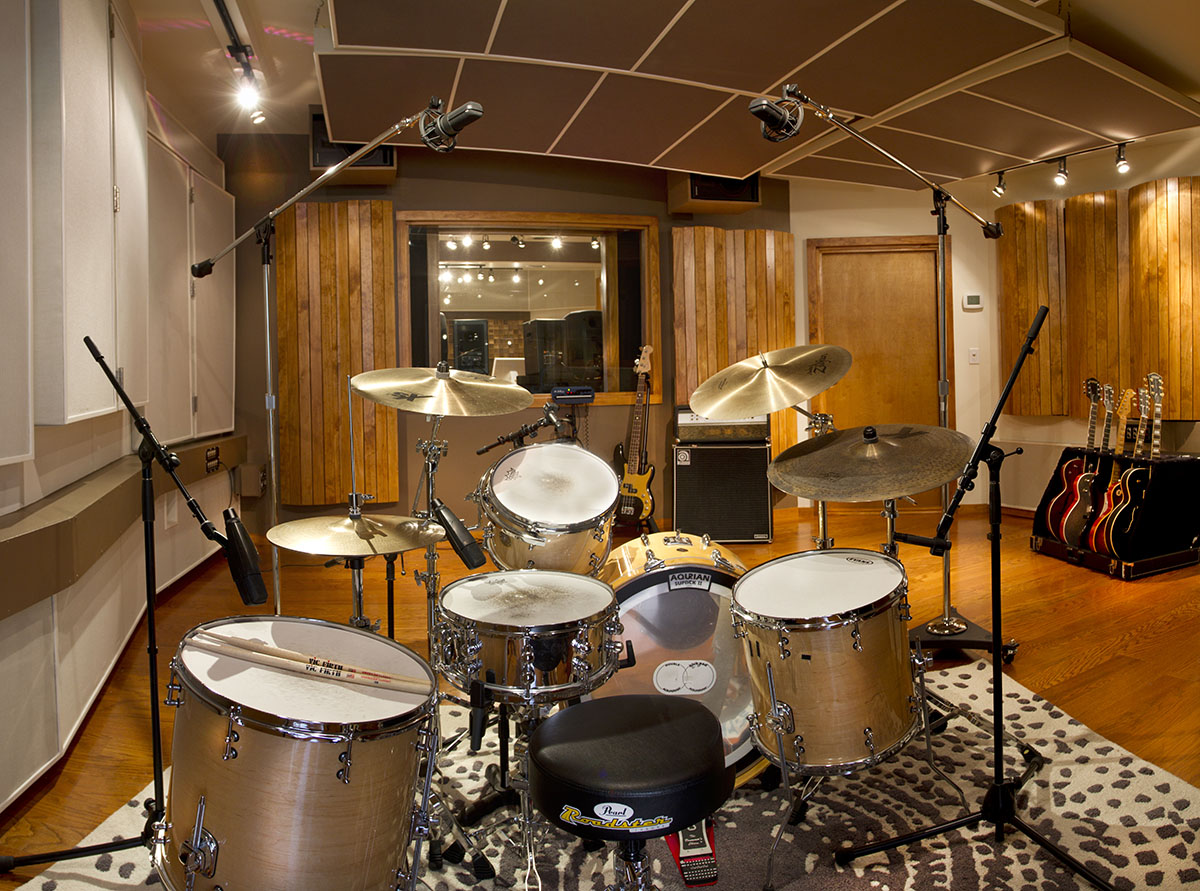
You’ve been playing your guitar after long days at the office. It’s become your de-stresser, your hour or so of refuge. And darn if you haven’t gotten pretty good at it. You like what you hear, and you want others to hear it, too.
What now? It’s time for a home recording studio. They come in all shapes and sizes and budgets, from a microphone and laptop in your bedroom that costs a couple grand, to a custom-constructed space with tons of instruments and gear — which can run up to $500K. More, if you go nuts.
Tom Morris, who has with his brother Jim owned and run Tampa Bay’s premier recording studio, Morrissound, since 1981, acts as a consultant for people looking to build home studios. First, “You have to decide what you want to use it for,” he explains. “It runs the gamut. Are you the tech guy who loves engineering, the knobs and faders? Do you hate all that and just want to push a button and record? Are you planning to record just yourself, for fun? Or do you want to turn part of your house, or your garage, into a recording studio and bring in whole bands?”
The most common type, says Tom, is the hobbyist musician who earmarks a spare room and sets up a studio to fit his or her needs. “The vast majority of people I’ve worked with are one room, one person,” he says. And while occasionally he’ll help a tech head who wants to program beats, most often it’s a musician who plays an instrument, perhaps sings and might want to lay down some digital backing tracks.
In that scenario, you start with basic acoustic engineering, Tom says. You’ve got to get rid of those parallel walls, which you find in most rectangular-shaped spare rooms. “Parallel walls cause horrible sound issues because the sound bounces back and forth and causes slapback echo,” Tom informs. The problem can be solved by placing a few acoustic panels at strategic angles. (Warning: don’t try this at home without expert assistance.) You can probably get this done for a couple thousand bucks, Tom says. There’s a company in Tampa, Acoustimac, that sells all sorts and sizes, and will install them, too.
Next you’ll need a relatively new computer to set up a digital workstation. A laptop might suffice for small projects, but Tom recommends a Mac Pro Tower — Macs are better than PCs, he says — with at last 64 gig of RAM. Equip it with Pro Tools, industry-standard software. You no longer need a mixing console or a rack of outboard gear and effects (echo, reverb, etc.). It’s all there in Pro Tools. We’re getting close.
Unless you plan on doing no singing, you’ll need at least one microphone. (Tom says the industry standard is a Neuman U-87, which runs about $3,000 new.) And you’ll need a microphone pre-amp that converts the analog sound to digital signal that goes into the computer. Guitar players can also play directly into the computer through a lightweight modeling amp. To finish your studio off, you’ll need a pair of monitor speakers to play back your music. “It’s probably the most personal choice you’ll make for your studio,” Tom says. What’s the estimated cost for this spare-room musical retreat? Tom says you can get it done for $30,000 to $50,000.
So what’s it like when you go big? Don Miggs is a professional musician, an alternative-rock singer/songwriter who also composes movie and TV scores. Several years ago, he and his wife, Lisa DeBartolo, bought the Palma Ceia home of Bob Basham, one of the founders of Outback Steakhouse. The property included a full-blown replica of an Outback. Don instantaneously saw his home studio. He went big, but he didn’t go crazy. At first.
Then he started accumulating more and more equipment. Lala Mansion, as the studio is called, has become a commercial enterprise and employs staff engineers. (Don says Boyz II Men, Candlebox and Plain White T’s have recorded there.) He still uses it for himself, though.
“It changed my life,” he says. “I worked hard to have a space that could be mine. So many people give up their dream for their kids. My kids are allowed in the studio at all times. The studio allows my dreams to co-exist. And it’s a space I can get lost in for several hours.”


